|
About twenty-two years ago, Ruger made a
few changes to their good old Standard Auto and Mark I Target
pistols and called the redesigned pistol the Mark II series.
With the exception of the .22/45 version of the Mark II that was
introduced in 1993, the line has remained pretty much unchanged
until a few months ago with the introduction of the new Mark III
series of rimfire auto pistols. While the Mark I to Mark
II changes were subtle, there have been some major design
changes with the introduction of the Mark III.
For review I obtained a new Mark III Hunter
stainless pistol from Ruger. This is one of the best-looking
twenty-two rimfire pistols ever produced by Ruger, or anyone
else for that matter. It has a six and seven-eighths inch fluted
barrel, half-checkered Cocobolo wood grip panels, and fiber
optic front with V-notch rear sights. The entire pistol except
for the sights, magazine, grip screws, grip panels, and trigger
are a satin stainless finish. The pistol is also drilled
and tapped for a Weaver-style scope base, which is provided with
the pistol. I will get to the specifics of this pistol later,
but first will address the changes made to Rugerís rimfire
pistols.
Most of the changes to the rimfire pistol line
are safety-related. The Mark III has a magazine disconnect
safety that prevents the pistol from being fired with the
magazine removed from the weapon. Unfortunately, some
inexperienced shooters believe that removing the magazine from a
pistol unloads the weapon, but there can still remain a
cartridge in the chamber. The magazine disconnect safety
prevents an inexperienced shooter from discharging the weapon
negligently after removing the magazine.
Another safety feature introduced into the Mark
III pistols is an internal key lock. In the Mark III, the key is
inserted after the thumb safety is applied, into a hole just
below the thumb safety, and then rotated. This prevents the
thumb safety from being slid into the "FIRE" position
until the internal lock is disengaged with the key. This key
lock can be used if the owner desires, or ignored if the owner
does not need such a device. The fact is that some jurisdictions
in the United States require such an internal lock, and more are
on the way. Ruger has provided this internal lock for those who
desire to use it, but it is very unobtrusive for those who
choose to not use the device. In other words, it is not in
the way, but is there for those who like it.
The third safety feature added to the Ruger
pistol is a loaded chamber indicator. This is a thin metal bar,
the rear of which protrudes slightly from the left side of the
receiver when a cartridge is present in the chamber. This device
can be easily seen, and can also be felt with the shooter's
finger. The bar is activated by a spring-loaded piece of steel
that touches the rim of the chambered cartridge. I was concerned
that this could possibly fire the cartridge if the gun were to
be dropped on a hard surface, landing on the loaded chamber
indicator; admittedly a remote possibility, but a concern
nonetheless. To test this feature, I loaded the chamber with a
live cartridge, and could easily push in on the bar. It would
push flush with the receiver. I then pointed the muzzle
downrange, and tapped the bar with a heavy brass hammer. No
matter how hard I smacked the loaded chamber indicator bar, it
would not even leave the slightest mark on the cartridge rim,
and cannot fire the pistol if dropped.
My favorite new feature of the Mark III pistol
is the placement of the magazine release button. The magazine
catch has been moved from the heel of the grip frame to a
position on the left side of the frame, just aft of the trigger
guard. This is where the mag release should be on an auto
pistol, and is a very welcome feature. When the button is
pressed, with the thumb of a right-handed shooter or the
forefinger of a left-handed shooter, the magazine drops free of
the frame. The loading button on the left side of the magazine
follower is also larger than that of the Mark II pistols, and
aids in easily loading the magazine to its ten round capacity.
Another minor change to the pistol with the
introduction of the Mark III is that the rear of the bolt which
is grasped to chamber the first round has been streamlined a
bit, but still provides a secure handle for a non-slip grip.
Addressing the particular features of the Mark
III Hunter, the most readily apparent is the stainless steel
fluted barrel. The six and seven-eighths inch barrel on
Rugerís Mark II line was always a good-shooting barrel length,
providing a greater sight radius than on their shorter barrels,
but was very muzzle heavy. The fluting on the Hunter relieves a
bit of the barrel weight without sacrificing stiffness, and
gives the pistol a nice balance. It has enough of a muzzle heavy
bias to point well, but not so much as to make it feel
cumbersome. The weight of the Mark III Hunter pistol with an
empty magazine is 40.3 ounces. I like the fluted barrel.
The grips of the Mark III Hunter are unique to
this pistol. They are of Cocobolo wood, checkered on the bottom
half, and left smooth on top. Thankfully, neither grip panel has
a target style thumb rest, which is greatly appreciated by this
left-handed shooter. The grips are very comfortable to use, and
offer a good secure grip on the handgun, while adding to the
overall beauty.
The sights on the Mark III Hunter are something
of which I have a mixed opinion. I have always done my best
target work with a Patridge type front sight and a square notch
rear. The Hunter has a V-notch rear sight with a fiber optic
front. The front sight has a ramped base with five
interchangeable fiber optic inserts of various colors and sizes.
The extras are contained in a handy little case with a tool for
compressing the spring to interchange them. The sight is very
quick for the eye to pick up and get on target, and works great
for hunting, especially in low light conditions. On a pistol
such as this that is meant for hunting, as the name suggests, it
is probably the best choice. Anyway, if the owner desires, the
sight can be easily replaced with a square notch and Patridge
for target work.
As mentioned above, the pistol also comes
supplied with a scope base that allows the mounting of any
optics that will bolt up to a Weaver base. I tried on this Ruger
a Trijicon TriPower red dot type scope that has a unique
inverted chevron reticle. The TriPower has four different ways
of lighting the reticle. First, it can be illuminated by battery
power that has intensity adjustments for any lighting condition.
Second, it has a light-gathering fiber optic system to gather
available light to illuminate the reticle. Thirdly, the reticle
is tritium powered for always-on capability, and fourth, the
sight has the option of using miniature cyalume sticks to light
the reticle. It is a very versatile sight that works well on the
Ruger Mark III Hunter, and I will use it on other weapons later
that are better suited for such a sight.
The base provided offers a lot of flexibility in
optics choices, and is not in the way of the open sights when
the optic is removed. For accuracy testing of the Hunter pistol,
I mounted a Bausch & Lomb 2 to 7 power pistol scope
in B-Square rings atop the scope base. I assembled
a variety of .22 Long Rifle ammunition that is suitable for
hunting purposes. I tested no special match grade ammo in this
pistol, as this pistol is intended for hunting, so I chose to
test it with hollowpoint and solid bullets that are designed for
small game and varmint hunting. The chart below shows the
results of the accuracy tests. The range was twenty-five yards,
and the pistol was fired from a two-handed rest position. The
weather conditions were not the best for such work, with a
gusting wind and an air temperature of between 19 and 22 degrees
Fahrenheit. Group sizes are listed in inches.
| Ammunition |
Group Size |
| Federal Lightning |
0.831" |
| Winchester XPert |
0.884" |
| Winchester Dynapoint |
0.969" |
| Federal Spitfire |
0.582" |
| Winchester Wildcat |
0.954" |
| Remington High Velocity Hollowpoint |
1.426" |
| Remington Cyclone |
0.592" |
| Olin Standard Velocity Solid |
0.626" |
| Remington Yellow Jacket |
1.000" |
| Hansen Standard Velocity Solid |
0.605" |
| PMC Zapper |
0.452" |
The trigger pull measured just under three
pounds, with no creep and just a bit of overtravel, and aided in
the impressive groups fired with this pistol. As can be readily
seen in the chart, this new pistol is a real shooter! Even with
the wind blowing and my fingers numb, the Mark III Hunter proved
to be a very accurate shooter. Functioning was flawless with all
loads tested. The best group was with PMC Zapper
hyper velocity ammo. The first four shots went into one ragged
hole, but I pulled the last one to the right, opening the group
up to .452 inch. Ten out of the eleven loads tested grouped into
one inch or less, with several around the half-inch mark. This
is target grade accuracy from a pistol using relatively cheap
hunting ammunition. Even the worst group of the day was under
one and one-half inches at twenty-five yards. I was amazed
and greatly impressed with the accuracy of this Ruger pistol.
When weather conditions improve, I intend to test the pistol
again at extended ranges.
With the new Mark III Hunter, Ruger has
introduced what is most likely the best-looking auto pistol that
they have ever produced. It is definitely the most accurate
Ruger pistol that I have ever fired, surpassing the best
accuracy available from pistols costing three times the price of
this Mark III Hunter. While marketed as a hunterís pistol, at
which it does excel, it is also an excellent choice for plinking
and informal target shooting. It is loaded with safety
features that make it marketable in todayís changing world,
but remains a very useful and superbly accurate pistol that is,
like all Ruger handguns, a very good value. It comes with a dark
green lockable hard plastic case, two magazines (thanks Ruger!),
instruction manual, scope base, key locks, and extra front sight
tubes.
I like the new Mark III Hunter, and highly
recommend it.
Check out the full line of Ruger products
here.
Jeff Quinn
|
To locate a dealer where you can
buy this gun, Click on the DEALER FINDER icon at: |
|

|
  
Got something to say about this article? Want to agree (or
disagree) with it? Click the following link to go to the GUNBlast Feedback Page.
|
|
Click pictures for a larger version.
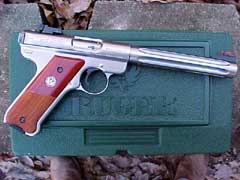
Ruger's Mark III Hunter .22 pistol.

The Mark III Hunter with accessories, including scope
mount, extra front sight inserts, and two magazines.
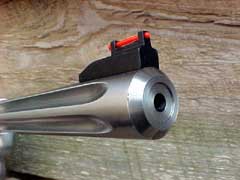

The Mark III Hunter features a very nice 6-7/8"
fluted barrel. Ruger's famous "warning" roll-mark is
located on the bottom of the barrel.

The Mark III Hunter's grips are made from cocobolo with
a half-smooth / half-checkered design. These grips are both
beautiful and practical for either right-handed or left-handed
shooters.
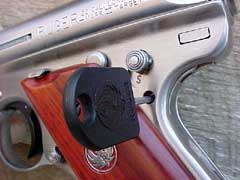
Ruger's new key lock system is easy to use and just as
easy to ignore as the shooter sees fit.
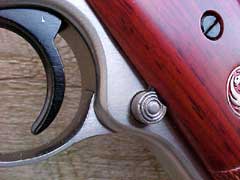
The Mark III replaces the old-style magazine release,
located on the heel of the grip frame, with a much easier to
use button perfectly located behind the trigger guard.

Another safety feature introduced on the Mark III series
is a spring-loaded visual and tactile loaded chamber
indicator.
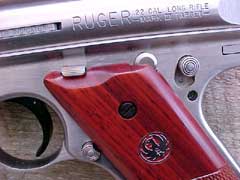
Thumb safety and bolt lever are located as on the Mark
II design.

The Mark III also features subtly redesigned bolt
grasping "ears".


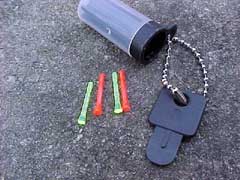
The Mark III Hunter features fully-adjustable V-notch
rear sight, and bead-type front sight with fiber-optic insert.
Extra front sight inserts are included.
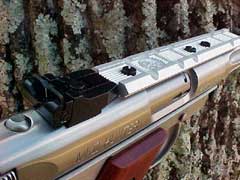
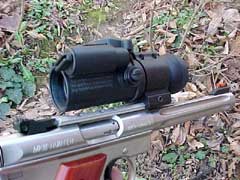

Also included with the Mark III Hunter is an excellent
Weaver-style scope mount, which allows for a wide variety of
scopes. The mount also allows an unimpeded view of the iron
sights when a scope sight is not installed.
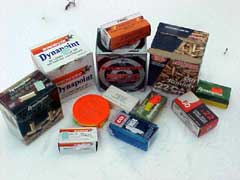
Author tested the Mark III Hunter with a good variety of
hunting-type .22 ammunition, and the Hunter proved to be a
very accurate performer with them all.
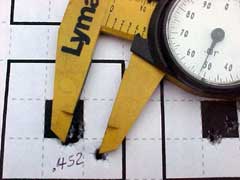
0.452" group with PMC Zapper ammo was the best, but
the Hunter proved to be capable of jaw-dropping accuracy with
a wide variety of loads tried. This is even more impressive
considering that accuracy testing was done in
less-than-favorable conditions, and that match-grade ammo was
not used.
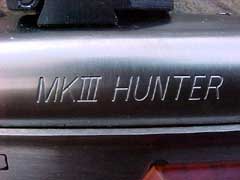
The folks at Ruger continue to introduce exciting new
products that are intelligently designed and reasonably
priced. It would be hard to imagine a better .22 pistol for
the hunter, plinker or casual target shooter. Ruger has done
it again!
|
![]()